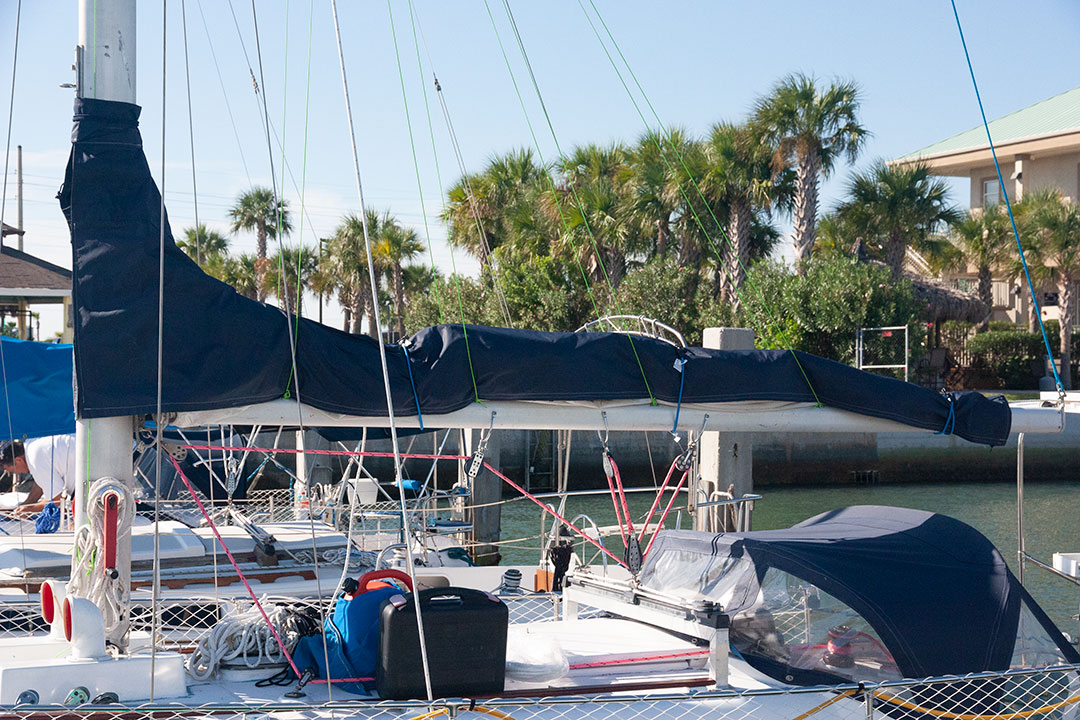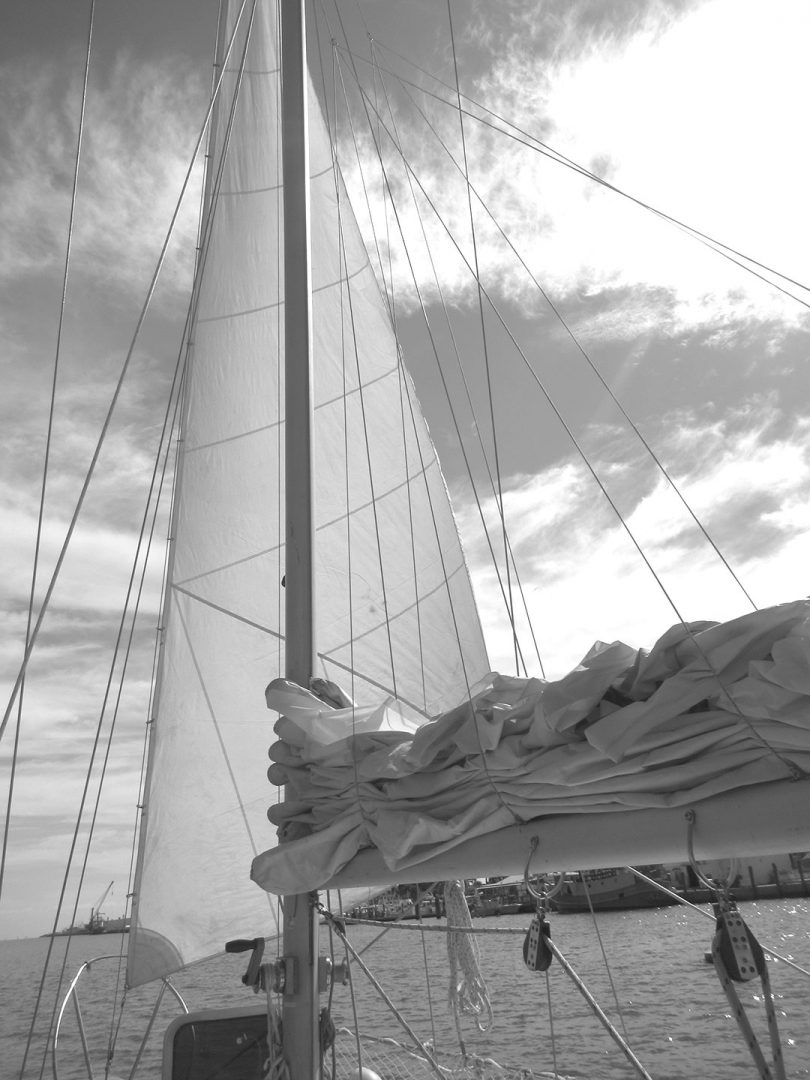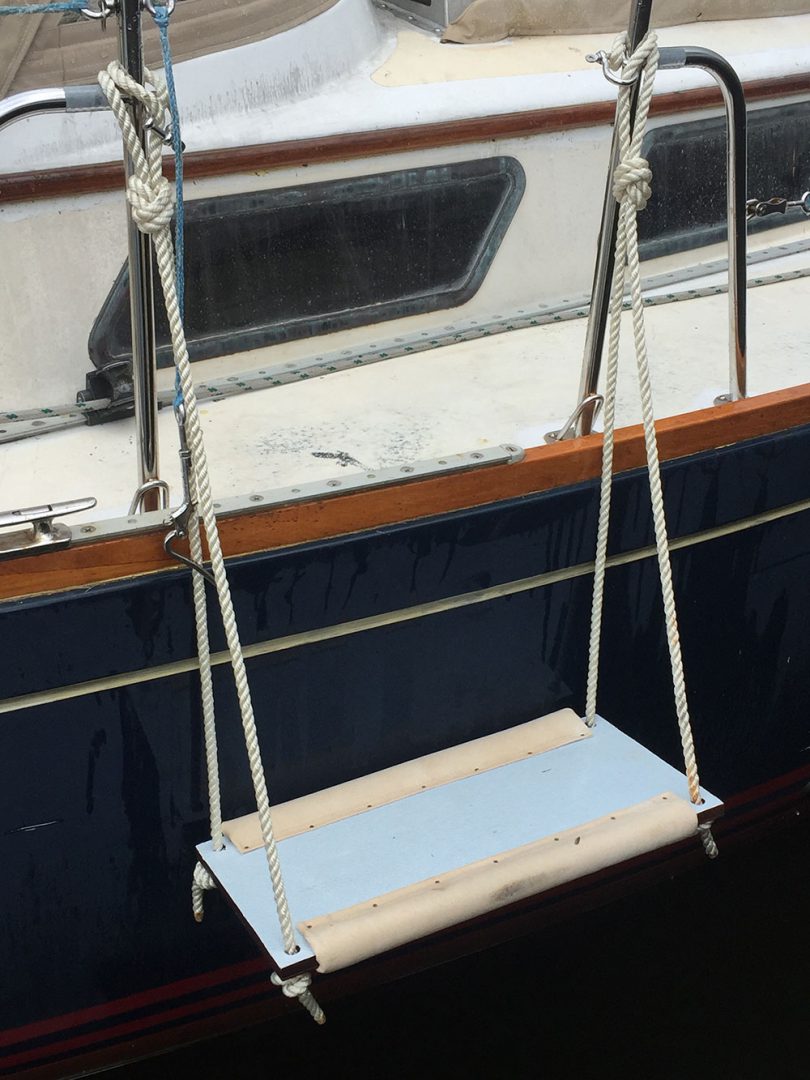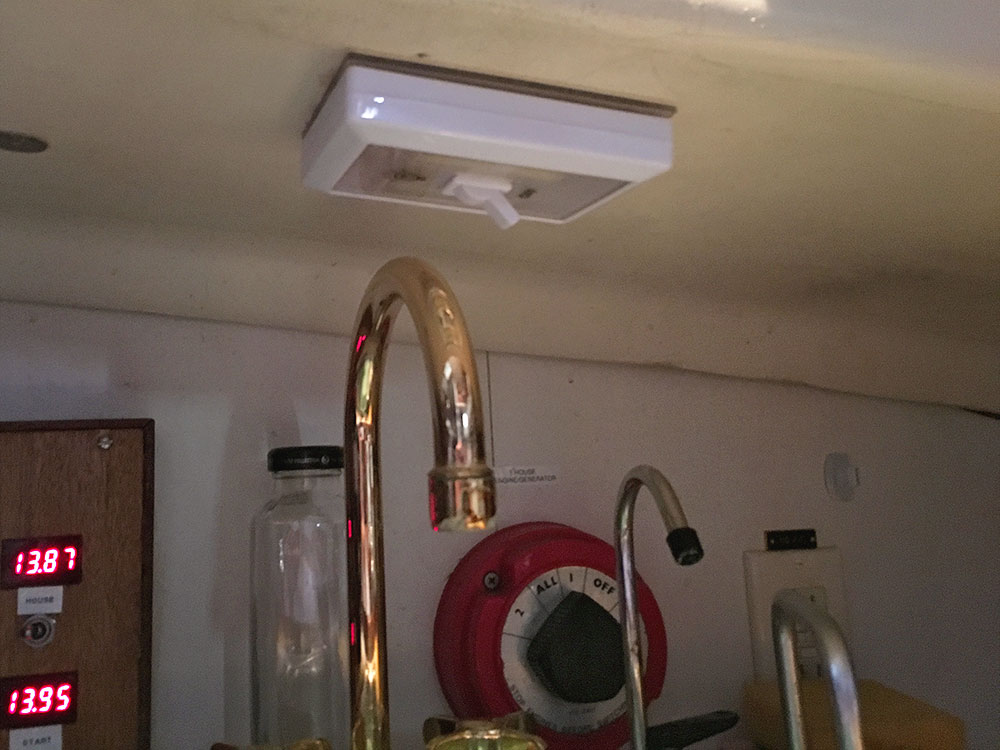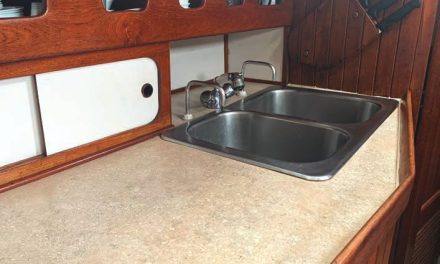Take the pain out of the main, make your own lazy-jacks
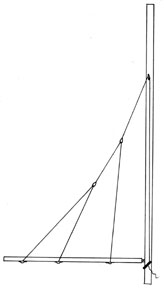
The easiest way for the shorthanded sailor to control the mainsail when reefing or stowing is a set of well-fitted lazy-jacks. Lazy-jacks are made from a set of fixed or movable lines led from the upper section of the mast to the boom, with lines on each side. They guide the sail onto the top of the boom when reefing or dousing it and keep it there to be tied up at the crew’s leisure.
When properly installed, a lazy-jack system adds to safety and sail control. Lazy-jacks function well with sails with no battens, half battens, or full battens. When installed and used correctly, they prevent chafe and tearing. A well-thought-out installation makes the lazy-jacks convenient to use, puts them out of the way when stowed, and does not require expensive alterations of sails or sail covers.
There are several varieties of lazy-jacks. The fixed systems permanently attach to the mast and are not stowed. These require altering the sail cover, may chafe the sail while sailing, and sail battens may catch in the lazy-jacks, making hoisting difficult. The better systems allow the lazy-jacks to be stowed and are deployed only when the sail is being doused or reefed.
Off-the-shelf and custom-built lazy-jack systems are available. Sail-loft versions start at $200; mid-range systems cost about $400; and high-end systems can cost $1,500 or more if professionally installed. A scratch-built system can be fabricated for less than the cheapest off-the-shelf systems, and has some advantages in the way it fits and functions with your boat.
Off-the-shelf lazy jack systems are not always better
The off-the-shelf lazy jack systems are not necessarily better designs. Most off-the-shelf systems use blocks at their segment junction points. When stowed, these blocks may bang on the mast. Correcting this situation requires the installation of hooks on the mast or boom and sections of shock cord to pull the support segment away from the mast. The need for blocks at the segment junctions is questionable, and they are more costly than thimbles.
Systems that use a line through the sail can cause sail chafe and require modifications to the sail and cover. Since the average do-it-yourself sailor can’t perform these modifications, the work can be expensive. These lines can also interfere with the shape of the sail when set. Changing the sail requires re-threading the lines through the sail each time it is changed or removed, neither a quick nor an easy task.
Some systems use shock cords to support the leg segments of the lazy-jacks. However, the shock cord provides too much stretch, and the sail may fall out of the lazy-jacks. Most of these systems use a plastic clip-on fitting to secure the lazy-jacks to the boom and mast. This plastic deteriorates in sunlight and often fails within a season or two.
With about an hour more than you would invest in the installation of an off-the-shelf lazy-jack system, you can make your own custom set, tailored to your boat.
Line choices
The line you select should match your splicing abilities and rig construction. There are four types to choose from: three-strand nylon; three-strand Dacron, standard double yacht braid, and more exotic fibers, such as Sta-Set X or Spectra line. Lazy jacks made of three-strand nylon for the average boat can be assembled for about $91. The same lazy jacks in Sta-Set would cost about $160. Don’t let cost be the only deciding factor; each line has advantages and disadvantages.
Three-strand nylon is simple to splice, requiring no tools and little knowledge. It’s inexpensive and available from most chandlers for 13 cents a foot or less for 1/4-inch diameter. However it is stretchy, so it is not as well-suited for high-aspect-ratio rigs where the stretch could allow the sail to fall off of the top of the boom. It’s susceptible to chafing where it contacts other lines, and it may cause twisting when deploying the lazy-jacks, necessitating the untwisting of the support lines.
While this is the cheapest line, with the most disadvantages, it served well on my 39-foot racer/ cruiser for more than five years, until recent replacement with double yacht braid. I’ve constructed a number of lazy-jack systems using three-strand nylon for people who wanted to spend as little as possible on the initial trial of the lazy-jack system. Each system I created with three-strand nylon has occasionally required some intervention to untwist the support lines. Using this line, you could first build a three-legged system, expand to a four-legged system, or experiment with other aspects. As it is the least expensive material, making radical changes in lazy-jack rigging rarely involves more than a $30 expense.
Less stretch
Three-strand Dacron is as easy to work with as three-strand nylon. It is less expensive than yacht braid or exotic fibers and has significantly less stretch than nylon: 4.2 percent compared to 16 percent when loaded to 15 percent of breaking strength. This makes lazy-jack deployment and tensioning easier. It has less tendency to twist than nylon, lasts longer, and is significantly less prone to chafe. It is also 10 to 20 percent stronger than the same-sized nylon. It looks great on traditionally rigged vessels on which the rest of the rigging is three-strand and costs about 18 cents a foot. A system constructed with three-strand Dacron for an average boat costs about $106.
Double yacht braid line has still less stretch than three-strand Dacron – only 2.4 percent. It is less prone to chafe than either of the three-strand lines and looks a lot more at home on a boat with braided running rigging. It is more difficult to splice than three-strand line, and splicing requires the use of a fid and pusher like those produced by Samson or the Splicing Wand from Brion Toss. Both come with excellent directions. Double yacht braid eliminates twist. It costs about 36 cents a foot. A system would cost about $160 for an average boat.
The exotic lines are more expensive, and there is no need to make your lazy-jack system out of these because lazy-jacks are not normally subject to the kinds of loads these lines are meant to handle. They do rate a single mention. Should your boat have an extremely high-aspect-ratio mainsail, you might wish to make the support segments out of Sta-Set X. This line is harder to splice but has the advantage of the least stretch for the money, at 1.6 percent stretch and about 59 cents per foot. This would reduce any tendency of the high-aspect-ratio sail to stretch out the lazy-jacks and fall off the top of the boom. An alternative to splicing might be a good seizing job; it’s almost as strong and a whole lot easier.
Excessive chafe

Chafe on the mast is an issue because of noise and wear.
With the exception of a turning block for the support segment, blocks are not well suited to use in lazy-jacks; they cause excessive chafe on the sail and bang on any surface they contact. They also add unnecessary expense to the installation. They’re prone to jamming when deploying the lazy-jacks and to sunlight damage to their sheaves. Blocks are meant to make adjusting a line under load easier, but in deploying your lazy-jacks there shouldn’t be any load. The weight of the sail is placed on the lazy jacks after they have been deployed and adjusted.
There are three types of thimbles available. These are used for the inserts that go into the eye splices to reduce the chafe and friction where the segments of the lazy jacks meet.
Galvanized steel thimbles are really cheap, but they rust quickly and make a mess of the sails, mast, and anything else they contact. Nylon thimbles are cheaper than stainless steel, are a nice white color, and won’t remove the surface coating of the mast should they come into contact with it. However, they do chafe more easily and are subject to degradation in sunlight, often being the first part of a lazy-jack system to fail. Stainless-steel thimbles last longer than nylon thimbles and have the least friction. If allowed to bang on the mast, they make a racket and remove the surface coating. I use them only when I’m certain they’re not going to contact the mast. They will outlast the rest of the lazy-jack system and probably even the boat itself.
Stainless wire
Most off-the-shelf systems use vinyl-coated stainless wire for support segments. The wires are mounted to pad-eyes on the mast. Since both ends of the support segment are next to the mast when the unit is stowed, the segment bangs against the mast in rolly or windy conditions. A fixed-support segment requires lazy-jacks to be adjusted, stowed, and deployed from a spot on the boom. The disadvantage is that you have to adjust them from the center of the boom. If you position the lazy-jack controls on the mast, it’s much easier to deploy them when the boom is moving or not centered on the boat.
Mounting control lines on the mast also makes it possible to mount the support segment blocks 6 to 8 inches out on the spreaders. This prevents banging on the mast. Mounting the support segment blocks on the spreaders works best on the upper spreader of double-spreader rigs. If your boat has a single-spreader rig, or if you are mounting to the lower spreader, three-strand nylon may stretch too much and let the sail fall off of the boom. In these cases, the easiest solution is to use a stiffer line.
For free-standing rigs, a general rule for the placement of the support segment blocks is: the higher the better. About 70 to 75 percent of the height of the mast off the deck provides a good angle. If the support segment blocks are too low, the tension is more forward than upward. In this situation, the sail pushes the lazy-jacks out of the way and falls off of the boom when it is lowered.
Spreader blocks
The parts list on the previous page is for a 40-foot boat I recently equipped with lazy-jacks. On this boat I was able to use spreader-mounted blocks for the support segment. The rig is modern, so we used 1/4-inch double yacht braid for the installation. Since the support segments were spreader-mounted, I used stainless-steel thimbles. If we had not been able to use the spreaders for the support segment blocks, I would have used two Harken 092 cheek blocks at a cost of about $8.79 each.
The first step in the installation is cutting the lines for the support segments. If you’re installing lazy jacks on a double-spreader rig and are able to use the spreaders as a mount for the support segment, measure the height of the second set of spreaders to the deck. Double this measurement and add 3 feet for splicing room. You will need to cut two lines this length for the support segments, one for each side of the mast.
If you are unable to use the spreaders as a mount for the support segments, you will want to mount the support segment blocks about 70 percent of the way up the mast. Measure this spot on the mast by using a long tape and a halyard. Make sure the area is clear of other fittings and there is sufficient room to mount the cheek blocks.
If you’re mounting the support segment blocks to the bottom of the spreaders, position them about 8 inches from the base of the spreaders at the mast. Double-check the location. If there are spreader lights, they must be far enough away that the line for the support segments will not chafe on them. Make sure the drill does not hit the spreader-light wiring.
Small dimple
Once you are certain there are no obstacles, use a center punch to make a small dimple as the mark for the first hole. Drill the hole, using a little light oil on the bit. Then lightly oil the tap and tap the hole, being careful to start and keep the tap perpendicular to the bottom of the spreader. With each turn you should turn the tap back a quarter of a turn. This helps to avoid breaking the tap off in the hole because it clears the chips from the tap. When the hole is tapped, spread some Ultra Tef-Gel or anti-seize on the screw, and screw one end of the eye strap into place just barely tight. Use the other end hole as a guide. Center punch on this mark, drill, and tap it as before. But before inserting the screw, slide the block onto the eye strap. String one of the two support-segment lines thorough the block, one end on each side of the lower spreader.
If you are mounting the support-segment cheek blocks to the mast, the procedure is much the same, except you are going to measure up to the position you determined earlier and mark in the middle of the side of the mast. Using the cheek block for a pattern, drill and tap each hole. Exercise caution while drilling in the mast; go slowly so as not to over-drill and damage wire or lines in the mast. Thread the support-segment lines through the blocks, keeping one end on each side of the spreaders below you (if any).
Next, mount the cleats on the mast. They should be about level with the end of the boom, on the side of the mast. Make sure they are not going to interfere with other control lines on the mast. If they do interfere, moving the cleats up or down several inches might solve the problem. If the area on the mast is too cluttered, you can mount them about a foot or so aft on the boom, making sure you lead the support-segment control lines aft of any spreaders to avoid chafe and noise. I’ve found that moving the bottom of the cleat slightly toward the bow of the boat makes cleating the support segments a lot easier than an absolutely vertical cleat.
Various effects
Boom length, batten length, and the hand of the sail cloth all have an effect on the perfect number and placement of the leg segments for the lazy-jacks. I have had excellent performance with three-legged systems with booms up to 16 feet. Many rigs have mainsails that are shorter on the foot than the length of the boom. In these cases the sail’s foot length is the critical measurement. The best way to determine the number and placement of the legs is trial and error; every rig is slightly different.
Here are some good starting points for placement, but they are only starting points; 20 minutes of testing will make sure that the lazy-jacks are dialed in perfectly for your boat. Measure 25 percent of the length of the foot of the sail, back from the gooseneck on the boom. Mark this position on the bottom of the boom. Repeat at 60 and 85 percent of the length of the foot of the sail, and mark the bottom of the boom for these points. These will be the starting position for the legs on a three-legged system.
Both the forward leg segment and the single line that makes up the middle and aft segments should initially be 2.5 times the length of the boom. The forward leg segment passes under the boom at the mark closest to the mast and is hoisted by the eyes spliced in the support segments. It, in turn, supports the after and center leg sections in a three-legged system.
The luff of the sail is held to the mast by the sail slides, so when adjusting the forward leg segment keep in mind that it should attach to the boom at about the most forward point where the sail first starts to fall off of the boom. About 25 percent of the sail’s foot length aft of the mast is a good starting point. Too far forward, and the leg provides no support for the center section of the sail; too far aft, and the top of the sail tends to fall off the boom.
Through thimbles
The aft and center leg sections in a three-legged system make a loop. They are supported by the forward leg segments where they pass through the thimbles spliced to the ends of the forward segment. The center leg segment supports the large belly of the sail so that the sail does not spill off the boom. Slight adjustments of the center segment fore and aft can have large results.
The aft leg attachment point is generally the first place to start adjusting the system. If the sail falls out the end of the lazy-jacks, you will need to move it aft; if the center section needs more support, try moving it forward to add some support to the center section.
When you are roughing in the system and testing it, attach the middle of one of these lines to the aftmost mark on the bottom of the boom, using a constrictor knot or some good tape wrapped a couple of times around the boom. Lead the ends forward to the center mark on the boom. Tie them together making a loop out of this line. Secure it to the boom with a constrictor knot or tape. You can use a loose bowline in place of all of the thimbles while testing.
On sails that have slides on the foot, it is often possible to use these slides as mounts for the leg segments of the lazy-jacks. This does, however, limit the options for placement, and does not function well in all cases. It also means that you will have to remove the leg segments from the boom to remove the sail.
Attached to boom
Now you have a roughed in lazy-jack system. The legs should be attached to the boom well enough that you can hoist and drop the sail into them. Hoist the sail on a calm day, drop it into the lazy-jacks, and adjust until the sail stays stacked on top of the boom.
Should you have a boom over 16 feet long and the sail falls out of the middle no matter what adjustments you make, you may need a four-legged system. A simple addition to the system you already are working on makes the transformation an easy one. Instead of the forward leg supporting the center and aft leg loop, as it does in a three-legged system, it is going to become a loop just like the one between the two aft segments. Connecting the two loops are two pieces of line, each about half the length of the boom, one on each side, that are supported by the support segment. Good starting positions for the boom attachment points on a four-legged system are at about 24 percent, 45 percent, 55 percent, and 84 percent of the boom length, measured aft from the gooseneck.
Once you have tested to make sure you have the legs roughly where you want them, test to see if the system stows cleanly away. To put the system in the stowed position, ease the support segments and place the aft side of the segments under the cleats on the mast, then tension the support segment halyard. At this point you may have to shorten the forward or aft leg segments to remove any excess line that drapes below the boom. Do this by simply retying your bowline on one side of the aft or forward section. The leg sections should lie parallel to the boom when stowed. Naturally, this may change the way the segments support the sail, so hoist the sail again and drop it into the lazy-jacks, making sure that everything still looks correct before splicing the thimbles in the ends and attaching the eye straps. This is the trial-and-error part.
Anti-seize compound
Mount the eye straps that hold the leg segments, with the holes fore and aft, using machine screws drilled and tapped into the bottom of the boom. Remember to put the lines through them before attaching the second screw. Some riggers use pop rivets for these attachments, however, I have not found them to hold up as well as properly tapped screws coated with anti-seize compound.
Tie a small knot on each side of the center of the leg segments under the boom to prevent having to readjust the system periodically. Alternately, a couple of stitches through the line and around each of the eye straps looks neater and serves the same function.
Splice thimbles into all of the segments where there are bowlines. Make sure that you place the line going through the thimble in the thimble to be spliced before making each of the splices.
Using the system is straightforward: simply ease the support segment halyards on the mast, remove the leg segments from the cleat bottoms, and tension the support segment halyards. The lazy-jacks are ready for use.
Deploying the lazy-jacks allows you to drop the mainsail any time the wind is on or forward of the beam. I have used them when picking up a mooring and when sliding into a slip under sail. Simply let the mainsheet out and drop the sail. Pull the mainsheet back in when the sail falls into the lazy-jacks and you have quickly de-powered without having to head into the wind.
If your sail should hang on the track and refuse to allow the sail to drop easily, check for bent sail slides, and lubricate the track and slides with a dry Teflon lubricant.
Readers’ comments: What about sail containment systems: lazy-jacks and furlers?
We asked our readers what their thoughts and experiences were with sail hoisting, dousing, and reefing systems.
- Don Launer, of Forked River, N. J., has lazy-jacks on the jib, foresail, and mainsail of his Ted Brewer-designed Lazy Jack Schooner (what else, right?). All three lazy-jack systems are simple two-legged arrangements that do not stow. Don reports that all work well, but he needs to go head-to-wind to hoist the Marconi mainsail.
- Ron Bohannon, of Big Bear City, Calif., says his previous boat, a Phil Rhodes Chesapeake 32, had a roller-furling main. (This is the older rolling-boom type of reefing where the sail stows around the boom, rather than inside of it.) He says this system works fine as long as a main is cut properly and the topping lift is adjusted correctly. He adds, “It sure is simpler than any other system.”
- Fred Bauer, of Marblehead, Mass., says, “I have a classic boat with old-fashioned lazy-jacks, but don’t miss the Hood Stow-away system.” He points out that Dodge Morgan had the Hood system on American Promise when he sailed around the world in her. Fred says, “It’s by far the easiest and most precise way to trim sails to the power of the wind I’ve ever used.”
- Patrick Matthiesen, of London, England, sent a detailed opinion of the Hood Stoboom. He thinks it may work well with short booms but did not work well on the 22-foot-long boom of his Sparkman & Stevens CCA 47 yawl. He would not have another one.
- Gary Heinrich, of Chippewa Falls, Wis., said that he has slab reefing on his S2 9.2 with “no furling system for the main, other than the arms of those available and, in a pinch, the deck and lifelines, followed by sail ties.” He has no plans to change his S2, but has chartered larger boats with lazy-jacks and sailcovers built into the sail. On these boats it was necessary to go head-to-wind to hoist the sail, and it took more than one person to do it.
- Larry Helber, of Rochester, N.Y., said he had installed a Schaefer lazy-jack system on his Grampian 28. He liked the leather-covered blocks and the one-cleat design for storing the lines. He felt the hardware supplied was of good quality. He did say, however, that the system turned out to be a very poor design and cited problems with raising the sail and jamming of the jacks where they pass under the boom. A friend of his bought the cheapest set of lazy-jacks he could find in a catalog, and they worked better. “I would do it again (install lazy-jacks), but I would choose the cheaper version,” he says.
- Bruce Goldman, of Southfield, Mich., reminds us that almost every aspect of sailing is some kind of compromise. “We have an in-mast ProFurl system on our Beneteau Oceanis 300. The convenience, ease of sail handling, and ease of setting and striking the main and genoa more than compensate for the sad sail shape (and resulting poor performance). We had some initial trouble with the furling line, but a good wash and ample Sailcote solved that problem.”
- Jerry Powlas and Karen Larson, of Maple Grove, Minn., wondered “how complicated does all this have to be?” Our 20-foot Flying Scot had a longer boom than our C&C 30. With such a short boom, our high-aspect-ratio mainsail couldn’t get in much trouble when we dropped it. It was not control that we needed, it was order. We wanted the main to flake neatly over the boom. Obviously a neat flake has alternating panels to port and starboard. We made a very neat flake in calm conditions and then marked the luff of the main with red and green permanent markers to show which side of the boom the sail should fall on at that point on the luff. We did the same for the roach.Now when we lower, the person at the halyard at the base of the mast guides the panels to port and starboard as they fall. The roach can be made neat at the same time by another person or later by the same person. Once the luff is laid down correctly, the roach can be made to follow with minimal effort. The main was soon so well-trained that it almost always falls correctly and unaided. We think the sail is too small to require extra gear to control it. We use the same red-green markings on our heavy 110-percent jib to help us get it flaked prior to bagging it. It works so well, we will probably mark all our jibs that way.
Article taken from Good Old Boat magazine: Volume 4, Number 4, July/August 2001.


